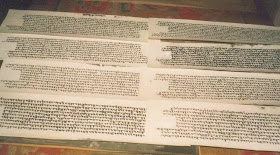It has been quite
a few decades since anyone has told me to “go to hell!’ But some time ago I actually
went there on my own accord. My brother who
lives in France, his family and I, were travelling through Provence and we
ended up in Val d’Enfer, the Valley of Hell. It is not just the
strangely-shaped rocks in the vicinity that gives this place its creepy name
but also the vast, labyrinthal underground quarry which has been mined since
Roman times. Where the light penetrates, the great halls appear white giving the impression of ice, an impression
reinforced by the subterranean cold. In other places it is all darkness and shadows. Away from the first several halls where most
of the visitors are it is dead quiet and solitary – everything you would need
for hell except heat. On the Buddhist concept of hell see http://www.buddhisma2z.com/content.php?id=328
Thursday, October 30, 2014
Monday, October 13, 2014
The Birds, The Beasts And The Buddha
Going
back nearly fourteen years ago I spent a few days in forested areas in Jamui and
Munger districts in Bihar. Less than 6% of Bihar is now forested and even much
of that is degraded. Nonetheless, this gave me at least some feel for what life
must have been like for monks and other ascetics during the Buddha’s time.
Sometime later I was asked if I
would write an article on nature
in the Buddhist scriptures and I agreed
to do so, thinking that there might be enough information to fill perhaps two
or three pages. However, as I began looking
for references I realized that the
scriptures actually contain a huge
amount of very detailed information on flora, fauna and the natural
environment. So what began as a brief article grew into a book which I have called Nature and the Environment in Early Buddhism. The book is now
available on line and you can read it at http://www.ocbs.org/on-line-publications I think most people will be surprised to know
in what detail the Tipitaka discusses the natural environment – soil types,
numerous ecological niches, different
types of water courses, cloud formations, etc. Altogether it also mentions some
700 different species of plants and animals. For me the greatest challenge was
not compiling all these names but trying to link them to their modern botanical and zoological nomenclature.
Everyone agrees that amba refers to the mango and kaka to the crow. But other than these
and a hundred or so others, no concerted
attempt has ever been made to identify all the flora and fauna mentioned in the
Tipitaka. Trying to do so has taken up a good amount of my spare time during
the last five years. In some cases I have succeeded, in others not. Either way the result gives, I think, a fascinating
insight into the natural world as the Buddha would have known it.
As for
the forests and their wildlife in Bihar the future does not look good, despite
the best efforts of the Forestry Dept and their dedicated officers in the
field. Population growth and administrative corruption insatiably eats away it
the few green areas left. The forest in Jamui is thoroughly unsafe nowadays,
not because of tigers but because it has
become a refuge for extremist Maoist guerrillas.

Sunday, October 5, 2014
Buddhist Treasures Lost Forever

The unprecedented
floods that swept Kashmir Valley last
month, have inflicted heavy damage to cultural and archival treasures
representing 2,000 yea the
historic Sri Pratap Singh Museum in Srinagar have been lost forever. Sources
told DNA that the important document, the Gilgit manuscripts, the only
surviving testimony to the Buddhist classic knowledge, has been lost forever.
Historians across the world were awaiting with
bated breath news about the fate of these documents, only to hear that they have been declared 100% damaged with no chances of
recovery. Suspecting that tribal raiders may damage these documents
in 1947, India's first prime minister Jawaharlal Nehru had prevailed upon then
government in Jammu and Kashmir
to shift them to National Archives in Delhi. On two other occasions, to protect them from
aerial bombings during war in 1965 and 1971 they were again flown to Delhi for
protection. Ironically, some of the
documents placed at the Central Asian Studies Department of Kashmir University
were returned to the Museum authorities just a week before the floods. Member
of National Monument Authority and former director of INTACH Salim Beg, who has
just returned from Srinagar after inspecting the loss said that not only
manuscripts but other significant treasures like paintings, shawls, historic
textiles, and wood carvings have been damaged. He was aghast that even when the waters receded, no action had been taken to rescue
the artefacts. He lamented that state authorities lack expertise or even basic
understanding to rescue the objects. Tracing the history of their discovery,
Beg says a shepherd had found them in 1931 accidentally and by the orders of
then Maharaja Hari Singh, they were placed in the museum. Since then scholars
from all over world arrive Srinagar to see these documents. Known as the oldest
manuscripts in the world, the Gilgit documents have an unmatched significance
in the area of Buddhist studies.
They help trace the evolution of Sanskrit, Chinese, Korean, Japanese and
Tibetan religio-philosophical literature. They were named Gilgit manuscripts as
they were discovered in three instalments in the Gilgit region, now part of
Pakistan occupied Kashmir. Fragments of these manuscripts are placed in the British Museum and
the Department of Archaeology in Karachi.
From DNA, 3 Oct. 20014







.jpg)
